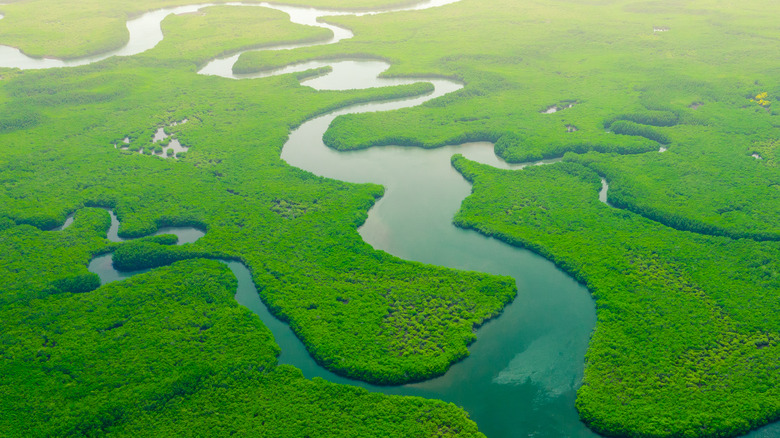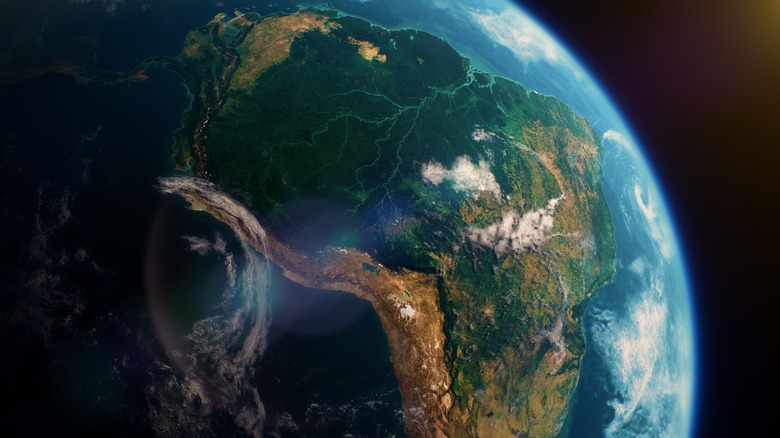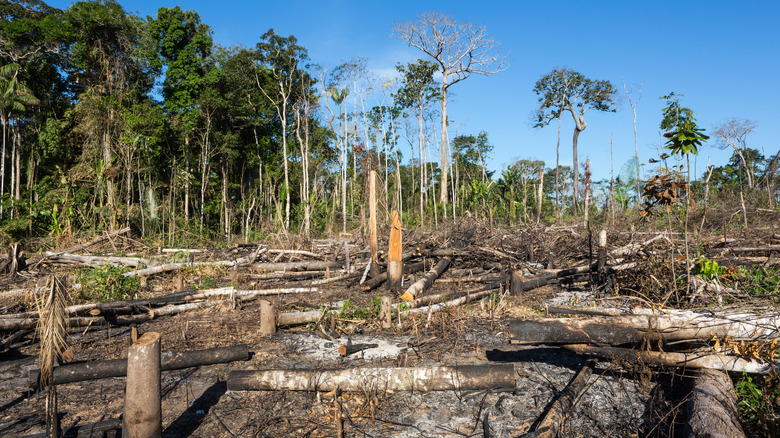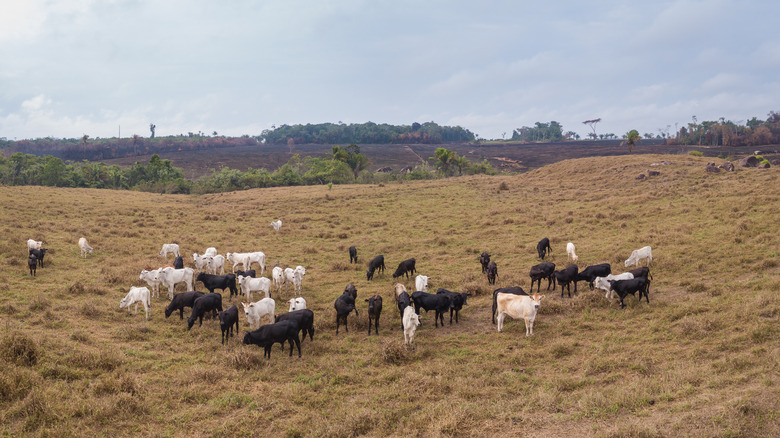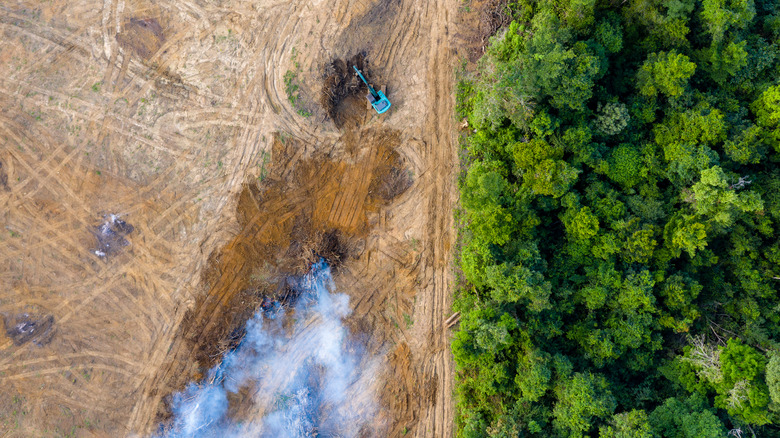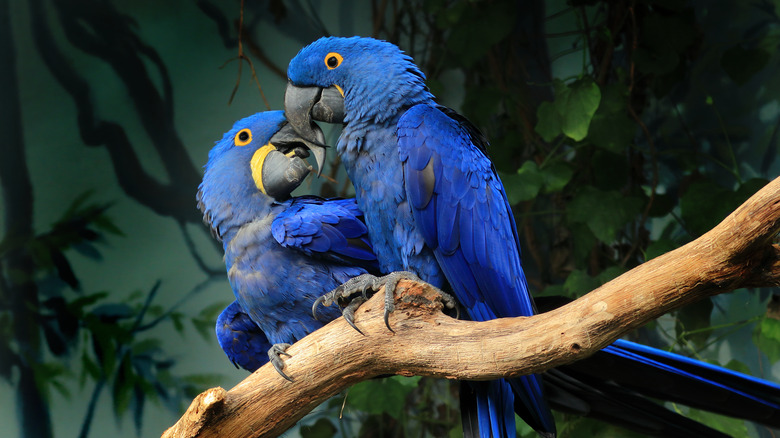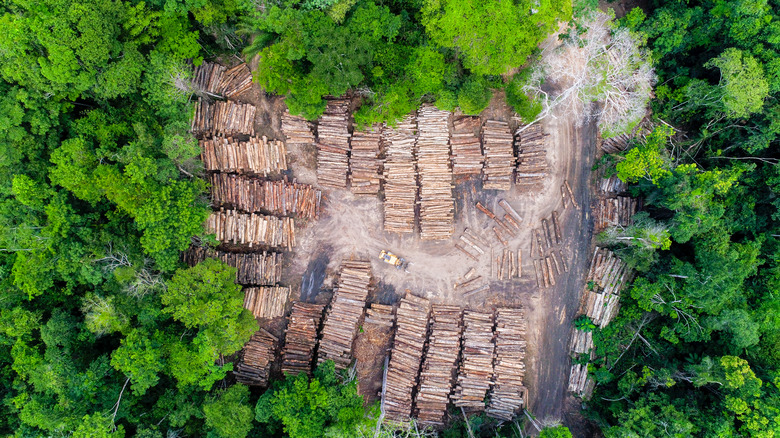Here's What Would Happen If The Amazon Rainforest Disappeared
The lush ecosystem of the Amazon rainforest in Brazil is home to thousands of animal species, bugs, and plants — for now (via Britannica). But with every year of destruction, the rainforest shrinks and dies a little more. Per Time, the 10 million-year-old forest has been around long before humanity, but human intervention forces us to ask the question: What would happen if the Amazon rainforest was completely destroyed?
Not everyone wants to save the Amazon rainforest, and Brazil's president, Jair Bolsonaro, is a big advocate for tearing down even more of the Amazon. During his terms in office, he has encouraged deforestation on a devastating scale: satellite photos revealed that the rate of tree chopping has spiked by more than 90% under his leadership, according to Time. He has done away with environmental protections and has openly opposed saving the Amazon from development.
As The New York Times reports, the more the Amazon is chipped away, the harder it is for the complex, long-standing ecosystem to grow back. The biodiverse landscape currently covers about 2 million square miles. And per USA Today, it holds about a quarter of the Earth's plant and animal species. The stakes couldn't be higher.
Heating up the Earth
When we think about the devastation of the Amazon rainforest, we tend to think of newly homeless animals with nowhere to go, the destruction of important plants, and the eradication of insect life, per The New York Times. It's all of these things and more.
The impacts will affect the Earth in ways that might not be immediately visible. For example, we can't literally see the 90 billion tons of carbon dioxide that the remaining Amazon forest contains. But we will feel it as those billions of tons of carbon emissions float into the atmosphere as trees are cut down, which will start to heat up the Earth even faster.
The rainforest could hold even more carbon than that estimate, according to USA Today — the Earth Innovation Institute reports that the trees store around 100 billion tons of carbon, which would quadruple when the area is raized, releasing the carbon into the atmosphere. In comparison, humans emit about 40 billion tons of carbon annually, and the Amazon's oxygen-producing plant life soaks up 2 billion of those tons each year. The New York Times reports that it will be way harder, if not impossible, to get climate change under control without the Amazon rainforest.
Fires and floods
The Amazon rainforest adds a lot of moisture into the atmosphere, which can be felt across the other continents (via The New York Times). The Amazon cools the Earth with all this moisture. As Ricardo Galvão, a former Brazillian deforestation monitor, warns, "If the Amazon is destroyed, it will be impossible to control global warming" (per Time).
As World Atlas reports, with fewer trees and plants to soak up rainfall like a sponge, the Brazilian landscape will be much more vulnerable to flooding. Catastrophic flooding has increased fivefold in recent decades, with devastating floods now occurring every four years on average.
Fires have been another threat to the Amazon: Statista reports that the Amazon is subjected to hundreds of thousands of fires each year, many illegal, which destroy the rainforest. In 2021, more than 150,000 fires scorched the rainforest. Per Britannica, these fires also boost the carbon dioxide levels in the air, heating the planet a bit more with each fire.
Buying the Amazon for cheap
The Amazon is also home to people (per USA Today). There are between 400 to 500 indigenous groups living in the rainforest who will be uprooted as the destruction intrudes on their homeland. World Atlas reports that the Amazon inhabitants could lose the farmland that sustains them, sending them into poverty. Plus, they could lose access to the Amazon landscape they have always known, which provides them with food, water, and building materials.
In 2020, the Brazilian portion of the Amazon was stripped of another 1.7 million hectares of forest land, per Statista. In fact, Brazil was the country that had the most forest loss in 2020 by a huge margin, as illegal loggers took advantage of the COVID-19 outbreak to harvest the plentiful trees.
Brazilian land is sold off illegally and constantly (via Time). Farmers can buy their very own scrap of the Amazon for just a few hundred dollars. They're then free to cut down trees, scythe plants, and run off native animals in order to build farms or villages.
Rainforest turned savanna
The New York Times reports that drought conditions have also hurt the rainforest, and as more is destroyed, the remaining plant life has trouble recovering. That's a shame too because studies have shown that the rainforest is actually really resilient, and will reemerge with fresh life if it's left alone for some time.
If it isn't given time to recover, and the land around it is raized, the rainforest instead gets drier. It's a repeating cycle that the Amazon cannot sustain forever, as studies have shown the resilience of the rainforest decreases with its size. What will the Amazon rainforest look like when the last trees are burned or felled, when the final plants are uprooted, and the last animals are killed or run off the land? There is so much to lose.
Lots of animals will become extinct without their specialized rainforest habitat, per Britannica. There are so many millions of species in the Amazon that scientists haven't discovered them all yet, and possibly never will. As the rainforest is eliminated, it will be replaced with a sort of savanna landscape. Instead of the lush, wet forests, the Amazon will be dry and barren, with few trees and plants surviving on nutrient-deficient soil. It would basically become the opposite environment of what the Amazon is now.
Miracle cures hidden in the rainforest
The New York Times reports that this change is irreversible, and once the Amazon becomes a savanna, it may never return to its former rainforest state. Once the Amazon has disappeared, it won't return in our lifetime, and perhaps not for centuries afterward. The accelerated rate of destruction has cost about 17% of the Amazon's surface in just the last 50 years.
The loss of the Amazon would mean losing potentially life-saving remedies, too, per World Atlas. Plants, animals, and minerals can contain chemicals that could be the cure for any number of diseases, but if the species disappear before scientists can study their potential effects, we will never know what cures or remedies we could be missing out on. For one example, according to Reuters, the majority of cancer treatments we have today were originally found in plants or minerals; in another study of about 2,200 rainforest samples, 70 were revealed to have tumor-shrinking properties.
Time is running out for the Amazon rainforest
The cure for malaria was found in the Amazon rainforest, too. Per Science, this will be especially important as the next generation of scientists try to discover new diseases before they cause the next epidemic or pandemic outbreak in humans.With as many as 400 species of plant life per hectare of the Amazon rainforest, according to Reuters, scientists have their work cut out for them in a race against rapid deforestation.
And time is running out. By 2030, as Time reports, more than a quarter of the Amazon will have no trees at all. Humans have already cut a Texas-sized chunk of trees down in the Brazillian Amazon. In a recent study, researchers found that the rainforest is having an increasingly hard time recovering from deforestation.
The New York Times interviewed Paulo Brando, who researches tropical ecology at the University of California. He said, "That lack of resilience shows that, indeed, there is only so much of a beating that this forest can take."
